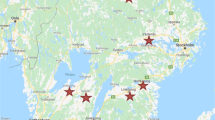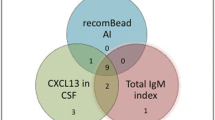Summary
Within 24 months in a consecutive series of 84 children with neurological symptoms indicative of Lyme borreliosis of the central nervous system (CNS) 45 seronegative children (group III), 17 seropositive (group II), and 22 children with specificBorrelia burgdorferi results in cerebrospinal fluid (CSF) — i.e.B. burgdorferi antibodies and/or intrathecally producedB. burgdorferi antibodies and/or positiveB. burgdorferi culture in CSF were observed. The results show that intrathecally producedB. burgdorferi antibodies are the most important marker for the diagnosis of neuroborreliosis (with 71.4% positives) andB. burgdorferi cultivation directly from CSF may be successful in the earliest phase of the disease. Since each of the specific CSF parameters may be false negative in some cases, a careful synopsis of laboratory parameters was done. It shows that CSF protein and CSF cell values are higher in group I than in II or III. Neither can seronegativity exclude nor can seropositivity confirm the diagnosis of neuroborreliosis as in only 71% of group I serumB. burgdorferi antibodies were detected. In view of these aspects clinical and laboratory results are discussed.
Zusammenfassung
Bei 84 Kindern mit Verdacht auf Neuroborreliose wurde der klinische Verlauf und eine Palette spezifischer und unspezifischer Laborparameter aus Liquor und Serum untersucht. Als spezifische, für eine Neuroborreliose beweisende Parameter wurdenB. burgdorferi-Antikörper im Liquor und/oder intrathekal produzierteB. burgdorferi-Antikörper und/oder eine positiveB. burgdorferi-Kultur im Liquor gewertet. Diesen Kindern mit definitiver Neuroborreliose (Gruppe I, n=22) wurden 17 nur im SerumB. burgdorferi-positive (Gruppe II) und 45B. burgdorferi seronegative Kinder (Gruppe III) gegenübergestellt und die unspezifischen Parameter im Gruppenvergleich auf ihre Borrelienrelevanz hin überprüft. Aus klinischer Sicht zeigt sich, daß die neurologische Erkrankung oftmals die Erstmanifestation der Lyme Borreliose im Kindesalter ist (seröse Meningitis und/oder Hirnnervenparese), die nach adäquater antibiotischer Therapie in der Regel auscheilt. Aus den serologischen Ergebnissen ist abzuleiten, daß (1) zur Diagnose einer Neuroborreliose die Bestimmung von intrathekalen Antikörpern die höchste diagnostische Trefferquote aufweist (71,4%), (2) die Liquor-Kultur in frühen Krankheitsstadien aussichtsreich erscheint, (3) in Einzelfällen jeder der drei spezifischen Liquor-Parameter falschnegativ sein kann, (4) daß ein erhöhtes Liquor-Protein bei gesicherter Neuroborreliose deutlich häufiger als in den Vergleichsgruppen (II, III) anzutreffen ist und (5) daß ein positiverB. burgdorferi-Titer im Serum ebensowenig ein deutlicher Hinweis auf eine Neuroborreliose sein kann wie ein negativer eine solche ausschließt (71% seropositive in Gruppe I).
Similar content being viewed by others
References
Burger, I., Radda, A., Wewalka, G., Stanek, G. Untersuchungen zur Ökologie vonBorrelia burgdorferi. Mitt. Österr. Ges. Tropenmed. Parasitol. 7 (1985) 51–54.
Millner, M. M., Schimek, M. G., Spork, K. D., Schnizer, M. Lyme borreliosis in children. A controlled clinical study based on ELISA values. Eur. J. Pediatr. 148 (1989) 527–530.
Millner, M. M., Müllegger, R. R., Wawschinek, O.: Transiente oligoklonale Liquorbanden bei Neuroborreliose. In: Aktuelle Neuropädiatrie 1990, Springer Verlag, in press.
Christen, H. J., Bartlau, N., Hanefeld, F., Thomssen, R. Lyme Borreliose — häufigste Ursache der akuten peripheren Facialisparese im Kindesalter. Monatsschr. Kinderheilk. 137 (1989) 151–157.
Eichenfield, A. H., Goldsmith, D. P., Benach, J. L., Ross, A. H., Loeb, F. X., Doughty, R. A., Athreya, B. H. Childhood Lyme arthritis: experience in an endemic area. J. Pediatr. 109 (1986) 753–758.
Hobusch, D., Naumann, G., Popp, K., Schumacher, K., Rohmann, E. Neurologische Manifestationen bei Lyme Borreliose. Pädiat. Prax. 38 (1989) 1–6.
Leff, R. D., Akre, S. P. Late stage Lyme borreliosis in children. South. Med. J. 82 (1989) 954–956.
Pietrucha, D. Neurological manifestations of Lyme disease in children. Ann. Neurol. 28 (1990) 464.
Huber, A., Baumann, W. Klinische Manifestationen der Lyme-Borreliose im Kindesalter. Klin. Pädiatr. 201 (1989) 133–135.
Heininger, H., Ries, M., Christ, P., Harms, D. Simultaneous palsy of facial and vestibular nerve in a child with Lyme borreliosis. Eur. J. Pediatr. 149 (1990) 781–782.
Jorbeck, H. J., Gustafsson, P. M., Lind, H. C., Stiernstedt, G. T. Tick-borneBorrelia meningitis in children — an outbreak in the Kalmar area during the summer of 1984. Acta. Paediatr. Scand. 76 (1987) 228–233.
Mühlendahl, K. E. Borreliose mit Meningitis als Ursache für Pseudotumor cerebri. Pädiatr. Prax. 37 (1988) 675–677.
Jacobson, D. M., Frens, D. B. Pseudotumor cerebri syndrome associated with Lyme disease. Am. J. Opthalm. 79 (1989) 12–15.
Lock, G., Berger, G., Gröbe, H. Neuroborreliose: Progressive Enzephalomyelitis mit Vaskulitis. Monatsschr. Kinderheilkd. 137 (1989) 101–104.
Schaad, U. B., Flueler, U., Schaub, H., Suter, H., Vischer, D., Caflisch, U., Tschumi, A., Wick, H., Vest, M., Durrer, D. Lyme disease in pediatric patients in Swizerland caused byBorrelia burgdorferi. Schweiz. Med. Wochenschr. 116 (1986) 1426–1430.
Christen, H. J., Hanefeld, F. Neurologic complications of erythema migrans disease — clinical aspects. Zbl. Bact. Hyg. A 263 (1987) 337–342.
Neumärker, K. J., Dudeck, U., Plaza, P. Borrelien-Enzephalitis und Katatonie im Jugendalter. Nervenarzt 60 (1989) 115–119.
Ackermann, R., Rhese-Küpper, B., Gollmer, E., Schmidt, R. Chronic neurologic manifestations of erythema migrans borreliosis. Ann. N. Y. Acad. Sci. 539 (1988) 16–23.
Millner, M. M., Muellegger, R. R., Schimek, M. G., Stanek, G.: Neuroborreliosis in children: direct demonstration ofBorrelia burgdorferi in CSF of seronegative cases. Submitted to Ped. Inf. Dis. J.
Dotevall, L., Fuchs, D., Reibnegger, G. Wachter, H., Hagberg, L. Cerebrospinal fluid and serum neopterin levels in patients with Lyme neuroborreliosis. Infection 18 (1990) 210–214.
Millner, M. M., Muellegger, R. R., Stanek, G. A diagnostic score for neuroborreliosis. Ann. Neurol. 28 (1990) 463.
Author information
Authors and Affiliations
Rights and permissions
About this article
Cite this article
Miller, M.M., Müllegger, R.R., Spork, K.D. et al. Lyme borreliosis of central nervous system (CNS) in children: A diagnostic challenge. Infection 19, 273–278 (1991). https://doi.org/10.1007/BF01644966
Issue Date:
DOI: https://doi.org/10.1007/BF01644966




